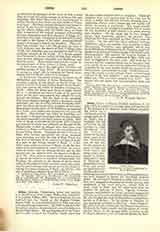

Jones, INIGO, a famous English architect, b. July 15, 1573, in London; d. June 21, 1652, and was buried in the chancel of St. Benet’s, Paul’s Wharf, London. His father was a clothworker in the neighborhood of St. Paul’s, and a Catholic; the son adhered to his father’s faith throughout his life. Little is known of the first thirty years of his life. Towards the end of the sixteenth century he went to Italy and lived there for many years, principally in Venice. Christian IV, King of Denmark, induced him to leave Italy and accept an appointment at the Danish Court. Buildings are named both in Italy and Denmark as having been designed by Jones, but seemingly without proof. He returned to England in 1604, and for some time was engaged in designing the costly scenery and machinery of the court masques. About 1614 he again went to Italy, and his notes show that he studied the writings of Serlio, Vignola, Fontana, Labacco, and Philibert de l’Orme, and was acquainted with the most famous architects then living in Rome. He also studied the style of Renaissance architecture known as Palladian. On his return to England he was appointed surveyor to the king. Jones designed the queen’s house, Greenwich, the banqueting house, Whitehall, St. Paul’s church and the piazza of Covent Garden (burnt to the ground 1795), a portico to old St. Paul’s cathedral, parts of Somerset House, the Barber Surgeons’ Hall (almost entirely destroyed now), Lindsey House, Shaftesbury House, etc. The Grange, Hants, and other country mansions at Coles-hill, Berks, Amesbury, Wilts, Wilton and Raynham Hall, Norfolk. He designed the garden front of St. John’s College, Oxford, and laid out Lincoln’s Inn (the first of the London squares). Jones’s later days were filled with adversity, and he died worn out with grief and disappointment. Of his genius as an architect there can be no question, nor can there be any as to his vast influence on the course of architecture in England; but as to the quality of his work and the effect of his influence, opinions differ very widely. His theory of architecture was that “it should be solid, proportional according to the rules, masculine and unaffected”. Much of his work, however, is classed as theatrical and his designs were never truly classical. At the request of the king, Jones wrote a book entitled “Stone-Heng Restored” in which he reaches the astonishing conclusion that Stonehenge is the remains of a Roman Temple of the Tuscan order.
THOMAS H. POOLE

